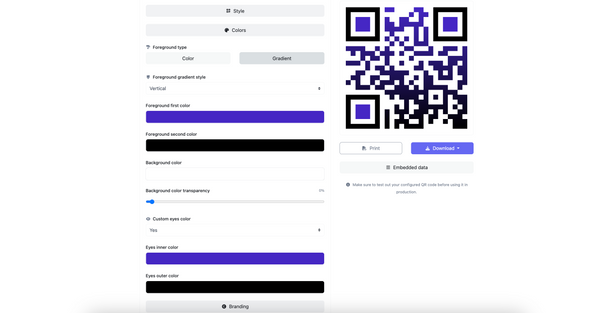QR codes have become ubiquitous in marketing, product packaging, and various forms of advertising.
But what happens when the destination needs to change after the QR code is already in circulation? That's where the process of redirecting a QR code comes into play.
This guide will explain how to redirect a QR code, its benefits, and insights. Let's begin!
Why Redirect QR Codes?
QR codes, those small, square matrices that we've grown accustomed to, are a testament to this dynamic environment. But what happens when the content they link to becomes outdated or irrelevant?
Let's explore the various reasons why users might need to redirect a QR code.
Outdated Information
The most common reason to redirect a QR code is outdated information. Consider this: you've printed thousands of flyers for an event with a QR code linking to the details. But what if the event details change?
You can't possibly recall all the flyers. Redirecting the QR code to updated information saves time and resources and maintains your credibility. It ensures that your audience always has access to the most current information, a crucial aspect in maintaining user trust and engagement.
Broken Links
We've all experienced the frustration of encountering a broken link. For businesses, a broken link on a widely distributed QR code can be more than just frustrating; it can damage the brand's reputation.
When a URL becomes inactive—due to website restructuring, expired domains, or other reasons—users who scan the QR code encounter error messages. Redirecting the QR code to an active, relevant URL is a quick fix that maintains the smooth user experience you strive to provide.
Changed Product Information
Products and services evolve. Sometimes, the information linked to a QR code needs to reflect these changes. For example, if a product has been upgraded, its QR code should lead to the latest information, not outdated specs or instructions. This is especially important in industries where up-to-date information can impact user safety or satisfaction.
Improved User Experience
Enhancing user experience is at the heart of why we redirect QR codes. When a user scans your code, they expect to be taken to a page that's relevant, informative, and engaging. If the content isn't up to par, you risk losing their interest and potentially their business.
By redirecting QR codes to content that is engaging, accessible, and relevant, you improve the overall user experience, thereby enhancing your brand's image and user satisfaction.
Better Analytics
QR code redirection can also be leveraged for better analytics. By using a redirectable QR code, you can track how many times the code was scanned, where it was scanned, and even what type of device was used.
This data is invaluable in understanding your audience's behavior and preferences, allowing for more targeted and effective marketing strategies. It's not just about counting scans; it's about gaining insights into how your audience interacts with your content.
Consistency in Campaigns
Marketing campaigns are often multi-faceted, utilizing various media channels. QR codes are a bridge between physical and digital mediums.
When the campaign's digital aspect changes—a new promotional video or a revamped product page—redirecting the QR code ensures consistency across all channels. This consistency is key to a coherent brand message and user experience.
Eco-Friendly and Cost-Effective
From an environmental and economic standpoint, redirecting QR codes is a sustainable choice. Instead of reprinting materials with new QR codes, which would be costly and wasteful, redirecting allows you to reuse existing materials. This saves money and aligns with eco-friendly practices by reducing waste.
Flexibility in Real-Time Marketing
In real-time marketing, where immediacy and relevance are paramount, the ability to change where a QR code points is incredibly beneficial. This flexibility allows businesses to respond quickly to market trends, current events, or user feedback, keeping their marketing efforts as relevant and impactful as possible.
Crisis Management
In times of crisis or misinformation, being able to redirect a QR code can be a critical tool. If a QR code leads to information that has become incorrect or harmful, immediate redirection can prevent the spread of misinformation and protect both users and the brand's reputation.
How to Redirect a QR Code (Step-by-Step)
Redirecting an existing QR code is a prime example of this adaptability in action. Whether you're updating information, fixing a broken link, or simply trying to improve the user experience, redirecting a QR code is a straightforward process.
Let's walk through the steps to ensure your QR codes always link to the most relevant and up-to-date information.
Step 1: Opt for a QR Code Generator Tool
Begin by selecting a tool specialized in QR code editing or generation. For this tutorial, we'll be using QRCodeDynamic as our chosen platform to modify our QR code.
Step 2: Generate Your QR Code & Enable Dynamic QR Code Functionality
To create a brand new QR code, navigate to the homepage and select the "Generate Create QR Codes" option.
In case you're looking to update an existing QR code, simply log into your QRCodeDynamic account and pick the specific QR code you want to revise.
When setting up or revising your QR code, ensure that you opt for the dynamic QR code option. This is crucial for altering the QR code's destination.
Note that static QR codes cannot be converted into dynamic ones; thus, you might have to create a new dynamic QR code if your original one was static.
Now, input the desired URL that your QR code will redirect to. This could be a link to any digital content, like a webpage, video, or form.
With a dynamic QR code, you can modify the destination even post-printing, offering flexibility to change the linked content as needed.
Step 3: Customize Your Dynamic QR Code
Head back to the URL QR code section and choose your newly created link from the list.
Customize and design your dynamic QR code using QRCodeDynamic's design options. You can tailor the color, shape, and overall style to align with your brand's identity.
After finalizing your design, click on 'Create.' Test the QR code using a scanning app to ensure it directs correctly to your chosen link.
Step 4: Distribute Your QR Code
Your dynamic QR code is now ready to be shared online or printed for physical distribution.
QRCodeDynamic provides options for printing and downloading your QR code for various uses.
Step 5: Redirect Your QR Code
Go to the "Links" page, and select the link of your dynamic QR code. Then, click "Edit".
Then, you can redirect your QR code by adjusting the link of your dynamic QR code.
Advantages of Redirectable QR Codes
QR codes are not just a bridge between the physical and digital realms; they are dynamic assets that every marketer should harness.
Let's explore the benefits of using redirectable QR codes and how they can revolutionize your marketing strategies.
Flexibility and Control
- Empowers you to change the destination URL without recreating or redistributing the QR code.
- Keeps your marketing campaigns agile and responsive to the ever-evolving business landscape.
Cost-Effective Updates
- Bypasses the expenses and complexities of updating printed materials.
- No need to reprint brochures, flyers, packaging, or any other materials where the QR code is deployed.
Enhanced User Experience
- Ensures a consistent and seamless journey for your audience.
- Enhances your brand's reliability and fosters a positive reputation among your consumers.
Eco-Friendly Approach
- Reduces the need for material reprinting, minimizing waste.
- Contributes to sustainable business practices and resonates with environmentally conscious consumers.
Better Engagement Tracking and Analytics
- Enables more effective tracking and analytics, even as the linked content changes.
- Provides valuable insights into user engagement and content effectiveness for refined marketing strategies.
Consistency in Branding and Design
- Maintains uniform branding and design across marketing materials.
- Reinforces brand recognition and contributes to a cohesive brand experience.
Real-Time Information Updates
- Allows instant content updates in a rapidly changing information landscape.
- Ideal for time-sensitive promotions, event details, or critical updates.
Crisis Management
- Offers a swift solution for redirecting users to correct or updated information in case of errors.
- Safeguards your brand's integrity during crises.
Versatility in Campaigns
- Finds applications in various campaigns across different organizational departments.
- From marketing and promotions to customer service and product management.
Increased Return on Investment (ROI)
- Boosts ROI through enhanced user experience, reduced costs, and valuable analytics.
- Offers a cost-effective means to engage with your audience and adapt to changes.
Simplified A/B Testing
- Simplifies A/B testing in marketing campaigns by allowing effortless alteration of the destination URL.
- Eliminates the need to create multiple QR codes for testing.
Future-Proofing Your Content
- Ensures that physical marketing assets remain pertinent and efficient as your business evolves.
- Saves time and resources in the long run.
Tips for Redirecting QR Codes Effectively
Redirecting QR codes is a smart strategy in our digital era, but it requires some know-how to do it effectively.
Whether you're a seasoned marketer or new to the world of QR codes, these tips will guide you through the process of QR code redirection, ensuring that your efforts are successful and impactful. Let's dive into some valuable tips to make the most out of your QR code redirection strategy.
Understand Your Audience
Before redirecting a QR code, it's crucial to understand your audience. Knowing who will be scanning your QR code and what they expect to find helps create relevant and engaging content. Tailor the content to your audience's preferences and needs to ensure a better user experience and increased engagement.
Keep URLs Short and Simple
When creating a new URL for your QR code, keep it short and simple. Long URLs can make QR codes dense and harder to scan, especially on printed materials. Use a URL shortener to keep the URL concise and scannable if necessary.
Test Before Implementing
Always test the QR code before fully implementing it. Scan the QR code with different devices and apps to ensure it directs to the correct URL and loads properly. Testing helps identify any issues that might hinder the user experience.
Provide Clear Instructions
When distributing QR codes, provide clear instructions on how to use them. Not everyone is familiar with QR codes, so include a brief explanation or instructions on how to scan the code. This ensures that all potential users can access your content without confusion.
Use High-Quality Images
Ensure that the QR code is of high quality, especially when printing. A blurred or low-resolution QR code might be difficult or impossible to scan. Also, consider the size of the QR code; it should be large enough to be easily scanned but not so large that it dominates your marketing material.
Monitor and Analyze Performance
Utilize your QR code generator's tracking and analytics features to monitor your QR codes' performance. Analyzing scan data can provide insights into user behavior, such as when and where the QR code is scanned most. This information can help in refining your marketing strategies.
Update Content Regularly
Keep the content linked to your QR code fresh and updated. Regular updates encourage repeat scans and sustained engagement with your audience. Ensure the content is relevant and adds value to the user's experience.
Integrate with Other Marketing Strategies
QR codes should be part of a larger marketing strategy. Integrate them with your social media, website, email campaigns, and other marketing efforts to create a cohesive and comprehensive user experience.
Consider User Privacy and Security
When redirecting QR codes, be mindful of user privacy and security. Ensure that the destination URL is secure and that any collected data is handled responsibly and complies with privacy laws.
Plan for Longevity
When creating and redirecting QR codes, think long-term. Choose content that will be relevant for a longer period, and if the content does need to change, ensure that the transition is seamless for the user.
Utilize A/B Testing
Use A/B testing to compare the effectiveness of different content linked to your QR code. This can help determine what type of content resonates best with your audience and can lead to more successful campaigns in the future.
Stay Informed About Trends
Stay informed about the latest trends in QR code usage and technology. The digital landscape constantly evolves, and staying up-to-date can help you leverage new features and best practices.
Frequently Asked Questions
Can You Change a QR Code Link After Printing?
Absolutely! This is the beauty of dynamic QR codes. Unlike static QR codes, fixed to one URL, dynamic QR codes can be updated to redirect to a different URL even after printing. This feature makes them incredibly versatile and cost-effective for long-term use.
Will Redirecting My QR Code Change Its Appearance?
No, redirecting a QR code will not change its appearance. The design and structure of the QR code remain the same; only the destination URL is updated. You don't have to worry about reprinting materials with the QR code.
Can I Track the Performance of a Redirected QR Code?
Yes, you can track the performance of a redirected QR code if you use a dynamic QR code generator that includes tracking and analytics features. These tools can provide valuable insights into the number of scans, user location, and time of scans, helping you understand your audience better.
Conclusion
In conclusion, redirecting QR codes is a powerful, flexible, cost-effective strategy that can significantly enhance digital marketing and communication efforts.
Whether dealing with outdated information, improving user experience, or aiming for better analytics, QR codes offer a versatile solution. We hope this guide has shed light on QR code redirection's myriad benefits and practical steps.
Discover our latest blog posts:











